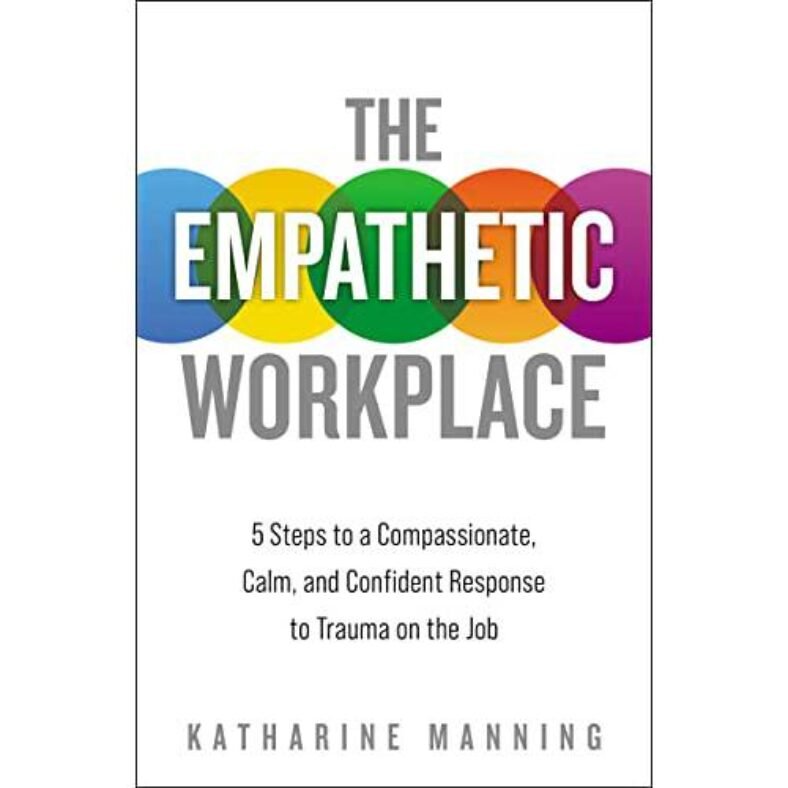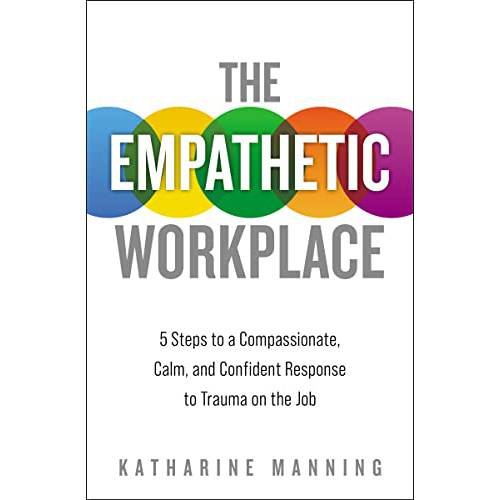This vital useful resource provides managers, HR, and anybody who might come into contact with somebody in trauma—together with office violence, harassment, assault, sickness, dependancy, fraud, chapter, and extra—the instruments they should be ready for what lies forward.
This guide is essential for each supervisor or HR consultant who shouldn’t simply put together to sooner or later be confronted with a report of a traumatic expertise at work, however plan on it. This five-step technique will assist managers make survivors really feel supported and understood. The Empathetic Office guides supervisors of any stage by an understanding of how tales of trauma affect the mind of each the survivor and the listener, in addition to the instruments to deal with the interplay appropriately, to assist the listener, the group, and most significantly, the survivor.
The straightforward-to-follow LASER technique outlined in these pages contains the next parts that every one managers ought to know and perceive:
- Hear-Controlling your individual response, managing your physique language, asking open-ended questions, listening to what isn’t being mentioned, and winding down the speaker when the dialog turns into unproductive are important parts in being a very good listener.
- Acknowledge-As soon as somebody shares a tough private story with you, it is very important acknowledge that present.
- Share-You possibly can assist the speaker regain some measure of management by sharing info with her or him about what occurred or what occurs subsequent, your private or organizational values, and what you don’t but know however hope to be taught.
- Empower-You possibly can assist the traumatized individual by offering her or him with assets which are out there to them by the corporate or exterior teams.
- Return-The ultimate step is to make sure that the traumatized individual has a option to come again later when she or he can’t keep in mind all that you just mentioned, thinks of extra questions, or needs for updates.
The LASER method can profit all who’re accountable for others, from top-tier managers at Fortune 500 corporations to Residence Advisors in faculty dormitories.










andrew e kent –
Katharine knocks it out of the park on this one. If you’re looking to build a more empathetic working environment, one in which team members feel safe to bring forth new ideas, you should be reading this book. It’s insightful and refreshing.
Timothy Holland Bernardi –
Managing a subject that can certainly be regarded as urgently topical, former Justice Department senior advisor Katharine Manning has compiled a concise guidebook that does not simply provide communication tools for managers and HR professionals, but also for anyone managing personal relationships impacted by the burdens that have we’ve all shouldered over the past 16 months. Foundationally, THE EMPATHETIC WORKPLACE re-introduces basic, effective skills in interpersonal communication. But its additional focus on the necessity to listen, acknowledge, share, empower and return (LASER) is worthy of consideration in a weary world. I highly recommend this read not only to business professionals and managers, but also parents, teachers, law enforcement and any other person who wants to better the process of safely and effectively reaching out. Bravo, Ms. Manning.
JS –
This book makes an enormously important contribution to the literature – Manning articulately shares her deeply informed knowledge, provides keen insights, and offers a workable roadmap to create kinder, gentler, and happier workplaces. A must-read!
G. Norman –
I should say, first, that Ms. Manning is both a colleague and a good friend. The disclosure being made, I also disclose that I want people to buy, to read, and to use Ms. Manning’s book because I believe in it’s premise. We all want to be better in how we treat others and how we treat ourselves. This book is a valuable and requisite first step in as they say, “walking the walk.” Ms. Manning ‘s expertise shines through in small, subtle ways, but it is hard to come by better: Ms. Manning reminds us that as listeners, we are not therapists and not counselors, we are listeners. My experience has been, in talking to organizational leaders, post-trauma or people with loved ones who are survivors. Is that they fear listening because they do not know how to do it. And, they are afraid of making it worse. Well, buying this book is the first step in no more excuses. My favorite sentence in the book discusses hubris. “There is hubris in the entire time that you, alone, do not need self-care, support, or the opportunity to discuss difficult things with which you come into contact.” Ms. Manning is correct – do not only buy the book for the HR person, buy it and read it with LASER focus
SHP –
Katherine Manning’s book, the Empathetic Workplace, is a must-read. Manning does a masterful job of laying out a simple to use rubric for how to approach issues in the workplace, offering both amazing research and her personal experiences as tools. Her background is stunning and speaks directly to how empathy figures into workplace conflicts. Not only is handling these matters the “right thing” to do, it is also the efficient one. People who feel supported in the workplace also are better performers and more loyal to their workplace, and what she recommends is not only good from an ethics standpoint but it also just good business. And her thoughts are incredibly accessible and practical. This is the modern-day “Getting to Yes” – a book that everyone must have because there is so much wisdom on every page. Cannot recommend it more highly!
M. Leonard –
How can we create caring relationships in our workplaces, communities, and home life? Using the L.A.S.E.R. method Katharine Manning delivers an easy-to-remember process to guide us through everyday practices of caring for friends and loved ones to supporting strangers, co-workers, and everything in between. Excellent resource for all but especially important for those in community-facing positions and management roles.
Robert Morris –
Katharine Manning recommends a five-step process — LASER — by which to establish and then nourish a workplace culture within which empathetic values are most likely to thrive. Her focus in on how to develop key skills in Listening, Acknowledging, Sharing, Empowering, and Returning to/reiterating essential information when responding to workplace trauma. She draws upon wide and deep experience, and is especially effective when examining the most important dos and don’ts to keep in mind. For example, when listening to a traumatized person’s account, concentrate on what you are being told rather than on what you will say in response. It is also important to be alert to [begin italics] what isn’t being said [end italics].Manning devotes a separate chapter to each of the five steps. As she explains, “The goal is to help you stay focused (laser focused) on what needs to happen in the interactions that to support the person who is experiencing something especially challenging. The LASER technique can benefit all who are responsible for others, from top tier managers at Fortune 500 companies to residence advisors in college dormitories.”These are among the passages of great interest and value to me, also listed to suggest the scope of Manning’s coverage:o Empathetic approach (Pages 3-6)o Impact of trauma in workplace (7-13)o LASER method (15-19)o Managing effects of trauma (24-26)o Pre-meeting groundwork for Listen step (39-43)o Active listening (45-54)o Open-ended questions (49-51)o Self-harm (73-76)o Victim blaming (107-112)o Avoiding judgment (108-112)o Apologies (139-144)o Follow-up (179-181)o Power of victims and counselors (183-186)o Compassion fatigue (186-189)o Benefits of LASER method (197-200)Crises are often unexpected and vary in nature, degree, and impact. When a direct report encounters one and needs assistance, counsel is best provided with empathy, composure, and confidence. Obviously, as the Roosevelt observation cited earlier correctly suggests, trust and respect must be earned prior to becoming involved in the given crisis.In this volume, Katherine Manning provides an abundance of practical information, insights, and counsel. Her readers will be well-prepared to be effective when called upon for assistance in almost any traumatic situation. That said, those who comprise an organization’s workplace culture will be empathetic only insofar as their leaders are.
Melanie G. Snyder –
Katharine Manning has crafted a clear, concise, confidence-inspiring roadmap that every organizational leader, supervisor and manager should have to empathetically and effectively support colleagues and staff (as well as anyone else in their circle) who may have experienced something traumatic and needs to talk about it, without feeling like they (the listener) need to serve as a therapist, counselor or problem-solver. One of the most practical, down-to-earth management/leadership books I’ve read in my decades of work in the corporate and non-profit worlds. Bravo!
Faye –
Great read! This thoughtful read is a must-have when navigating today’s workforce. Manning provides well-researched and actionable ways to create a responsible workplace.
Elizabeth –
Manning’s book The Empathetic Workplace is the book that all professionals need to read with the trauma from social injustice ever present, COVID grief and stress changing daily and the traditional work issues that haven’t disappeared. HR partners and managers alike would benefit from the specific steps that Katherine Manning outlined to respond to any revolution. The five step method is easy to follow and simply described to remember when needed.
Nicole R –
The Empathetic Workplace: 5 Steps to a Compassionate, Calm, and Confident Response to Trauma On the Job by Katharine ManningPublisher: HarperCollins LeadershipGenre: Self-HelpRelease Date: February 16, 2021The Empathetic Workplace: 5 Steps to a Compassionate, Calm, and Confident Response to Trauma On the Job by Katharine Manning is a fascinating read. One of my roles at my previous job was to work with people deal with “critical incidents” (traumatic death of a coworker, threat of violence in the workplace, etc.) so I was drawn to this book!While called something else, the process described is very similar to the CISM approach. It was refreshing to see that the methods I used can be applied in other situations.I would definitely recommend this book to anyone who supervises or supports a team. This will make a great reference book and will come in handy. The tools shared in this book will help grow trust among your team and make you a better leader.I’m so grateful to Katharine Manning, HarperCollins Leadership, and NetGalley for providing me with a free copy of this ARC ebook in exchange for my honest review.
Eliza Shulman –
Can’t say enough wonderful things about this book. As a leader in my organization it is important for me to understand how to respond to colleagues in distress as well as to create the right environment for people to feel safe to speak up. So much in this book is applicable not just to the workplace but to friendships and family as well. Manning’s guide will walk you through step by step how to navigate difficult situations and conversations and make you feel more confident as a leader.
Alexandra Weiss –
This book validated every thought I’ve had as an employee and manager over the past 20 years. It gave great insights into how to have a difficult conversation, and as a manager, I’ve employed these strategies wirh great success. Working in restaurants during the pandemic, every single one of my employees has faced trauma, as have I. In any industry, you must assume there has been trauma with your employees. Sure, empathy is not a learned attribute, however, this book teaches how to better tap into our empathy, the crux of our humanity, and take care of our employees. I’ll call this a must read for managers, and am asking our ownership to purchase copies for all managers in the company. A very useful book and a great read.
LFR –
Since the pandemic took hold, empathy and compassion have become buzzwords. What does it truly mean to listen and care for your fellow workers? In this timely and extremely helpful book, Katharine Manning lays out a specific framework with language to use in difficult situations that arise in your everyday workplaces.I recommend this book for new managers, seasoned leaders, and HR departments who are trying to implement more human-centric policies and programs and need a place to start.
Anna –
This may sound like a self-help book, and in a sense, it is. It will help you frame your approach with distressed individuals due to recent trauma, regardless of magnitude. Get a rocket-blaster of an email from someone that seems to have come from out of left field? Some of the strategies disclosed in this book will help you formulate a response that engages the angry person in a healthy way and bring them to a calmer state where they’re more willing to listen to what you have to say, bridging the communication gap. Interviewing a victim of abuse for the court case of the century? This book will also help with that. Have you ever found yourself saying, “I’m sorry you feel that way”? This book illustrates ways to apologize without sacrificing your integrity in a sticky situation. I highly recommend this book to anyone who deals with clients, employees, the public, or people in general–so, everyone! There is much to be gleaned here about how to improve working with people (on any scale) to get what you want. If you want to keep the drama in your life, this book is not for you.
Patrick Richards –
I have owned and managed businesses ranging from tech startups, to medical software and device companies, to professional service organizations. In my experience, the common element in all businesses is that successful managers know how to manage: (1) financial constraints; and (2) their people. In managing people, the best managers do more than manage a chain of command, they provide an environment in which their people can grow and thrive. In any organization, people will experience trauma, whether in the workplace directly or simply as a consequence of life outside of work. As a result, the best managers have the tools necessary to support their people through traumatic experiences.The Empathetic Workplace is absolutely most useful book I have found for growing my skills for supporting people experiencing trauma. This book has provided me with a practical roadmap based on the LASER method: Listen. Acknowledge. Share. Empower. Return.Read this book, value its lessons, grow your skills as a manager, and a succeed in building a business environment that empowers its people to make it through difficult times and support each other in truly meaningful ways.
booklover –
The Empathetic Workplace by Katharine Manning is marketed as a guide for managers who address trauma in the workplace. It is much more than that. It is an easy-to-understand guide any of us can use at home, in a relationship, or on the job.The author, who served as a counselor in high-profile cases like the Bernie Madoff and the Boston Marathon bombing, certainly is an expert on responding to victims in professional settings. Her new book is destined to become the go-to guide for managers. It is also an engaging handbook for parents, partners and anyone else who wants to become a better active listener.For all of us blundering through personal or professional conversations we didn’t expect, The Emphathetic Workplace is a step-by-step guide to dealing with complaints, surprises, revelations and friends in distress. That includes what to say when an allegation comes out of nowhere, when you suspect someone may be lying or when you possess information you are not able to share.Can’t think of the right words to lower the temperature of a conversation or to curtail a discussion that drags on aimlessly? Manning’s guide delivers them.And, unlike most workplace books, the author’s kindness and compassion come through in every chapter, making it a delight to read.